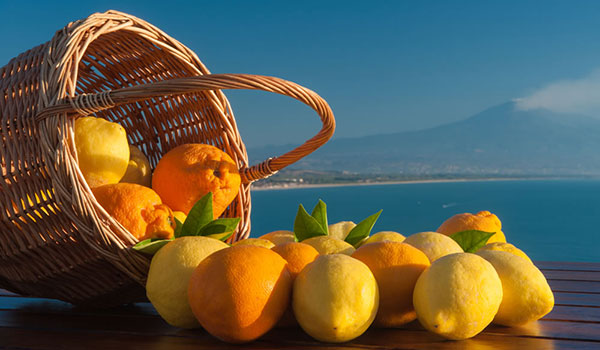
The Carthaginians, Greeks, Romans, Byzantines, Normans, Swedes, French and Spanish have all played a part in the history of Sicily, giving this area of Italy a continuous succession of armies, populations, dominations, enforcements, new rules and new traditions. It is for this reason that the question of ‘typical’ Sicilian cuisine is a complex one. The evolution of cooking traditions over the span of the centuries has been gradually ‘contaminated’ by the various populations and food products. Discovering Sicilian cooking is rather like taking a long trip back in time, to find a delicate balance of tastes and flavours. In looking at the evolution of the ‘taste of Sicily’, we should perhaps start with the Greek period, characterised by the arrival of olive trees, vines and an extensive cultivation of wheat. An important turning point then came with the start of the Arabic period, which brought not only citrus fruits, rice, jasmine, sugar cane and spices such as cinnamon and saffron to Sicilian cooking, but also introduced important techniques for fishing swordfish in Messina and tuna in Favignana, later to be perfected by the French and Spanish. The Arabs also brought couscous, once again adapted, to be prepared with fish, and the use of dried fruit, sultanas, pine nuts and almonds, to Sicilia cooking. The Arabic influence in sweets and desserts is no less evident. Some examples which clearly show the impact include sorbetto (a type of semi-liquid sorbet) and ‘cassata’ (a ricotta-based dessert with chocolate and candied fruits). Cassata is a sweet traditionally eaten at Easter time, and is of particular interest for its name, which derives from ‘qas at’ (meaning round, or bowl), and hints at the difficult balance between the idea of the extreme and of excess between riches and poverty to the limits of foodstuffs. Sicilians will ever be grateful to Emiro Ibn at –Timnah for the creation of timballi or arancine. Legend tells that Emiro was the original inventor of this dish, often going out hunting, taking these meat-filled small balls of rice cooked with saffron with him. Towards the end of the Arabic period, about a thousand years ago, there is evidence of this particular food production, in an area not far from the city of Palermo. This dish can be considered an ancestor of today’s spaghetti. Following this, there was a long period of Spanish domination, with the splendid outburst of Baroque art. This period was to have a lasting influence on Sicilian cooking methods, the effect of which can be easily appreciated simply by remembering the marvellous almond, pistachio and ricotta-based pastries produced in the enclosed convents scattered all over the island. This is also the period in which a splendid but somewhat easygoing aristocracy originated and its use of the highly skilled “monsù”. These were chefs who had been trained in France, and thus therefore integrated introduced into the elaborate island recipes, the skills in preparation and cooking with which they were familiar in central Europe. Furthermore, the Spanish period marked the arrival of chocolate from America, and the aubergine (egg-plant) from India. In the rich Countship of Modica, these new ingredients, together with beef and pork, gave life to those surprising, filled, desserts called mpanatigghi. Aubergine, fried with tomato, celery, olives and almonds, and prepared in an Arabian-style sweet and sour sauce, provided what was to become a cornerstone of Sicilian cooking, the dish known as caponata. This dish represents the synthesis between the two traditions of Sicilian cooking: on the one hand, the popular cuisine, dishes made with vegetables and simple products of the land, and on the other, the elaborate, sometimes lavish, preparation which was so popular amongst the aristocrats and upper classes. Another phenomenon of special relevance is the ‘street food’ of the city of Palermo. Foods such as bread, panelle (thin layers of chickpea flour, fried and filled with sliced bread), focacce (flat, grilled bread), frittelle (a type of pancake that can be sweet or savoury), timballi or arancine (as previously explained), and roasted meats testify to a lifestyle characterised by the importance given to the quality of all food, even that eaten whilst on the move. In Sicilian history the simple panelle, allowed a hungry population to forget the more substantial fish fry and could even be delivered to your home, this custom eventually led to the trade of the “buffettieri” (buffet-preparer), a word originating from the French ‘buffet’. As for wine, it is most certainly the ‘red thread’ that links all the various historical periods, with the influence of the Greeks, Piedmonts, Arabs, and others. It is also interesting to note that the Arabs demonstrated good common sense and a certain flexibility both on a gastronomic and a religious level. Sicily was a compulsory stopover for those coming from the Eastern part of the Mediterranean, so people from all walks of life found their way to the island. We would conclude with a suggestion for the reader’s breakfast and one of the simplest, and most representative dishes of the region: a lemon granita (crushedice drink) with a croissant hot from the oven, a truly delicious Arabic-French-Sicilian mix.


